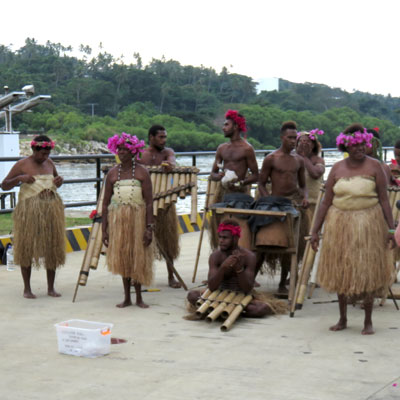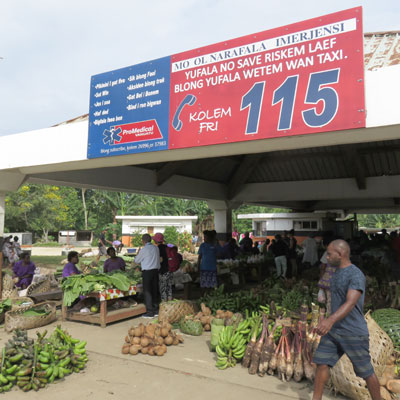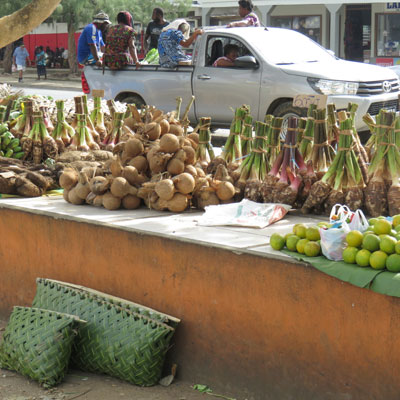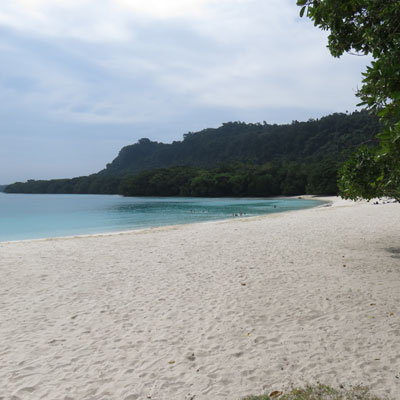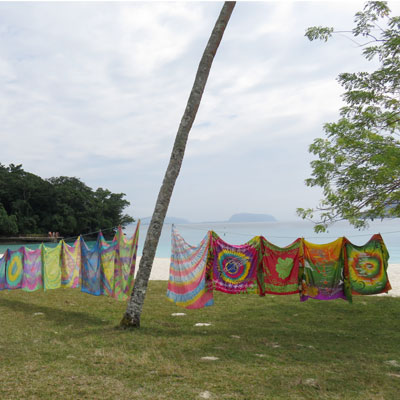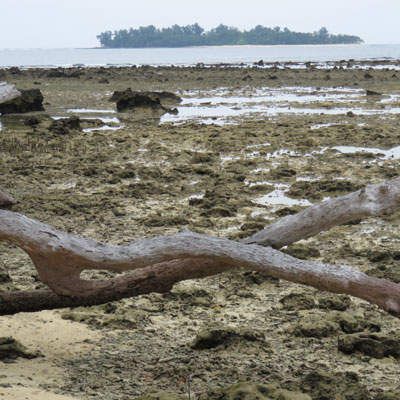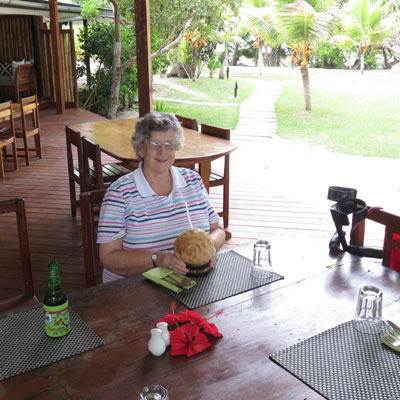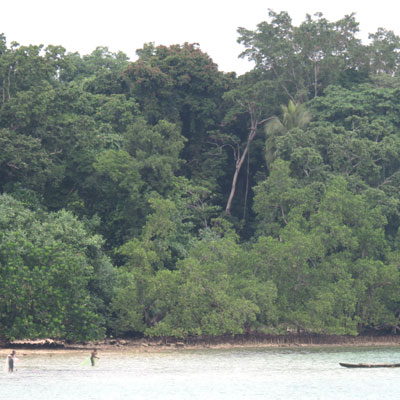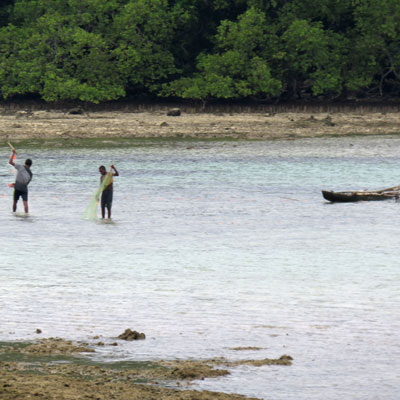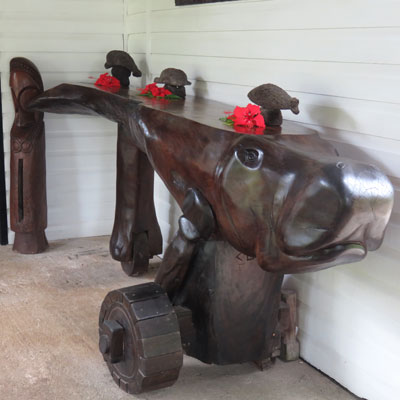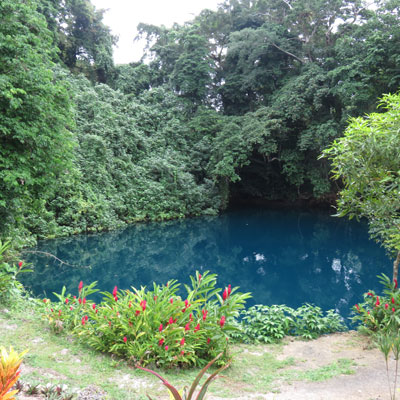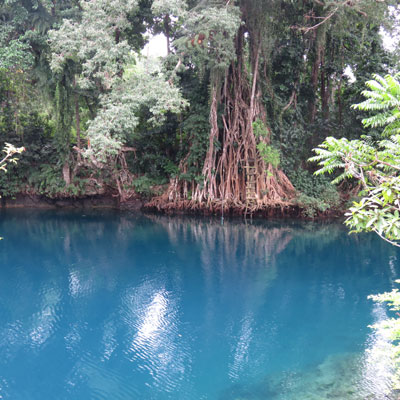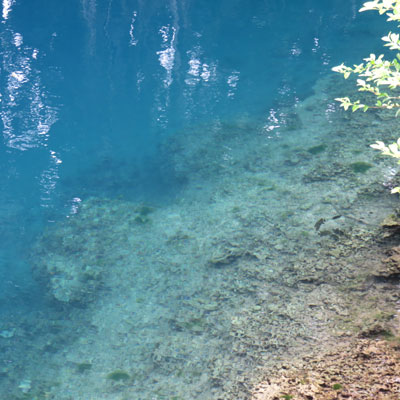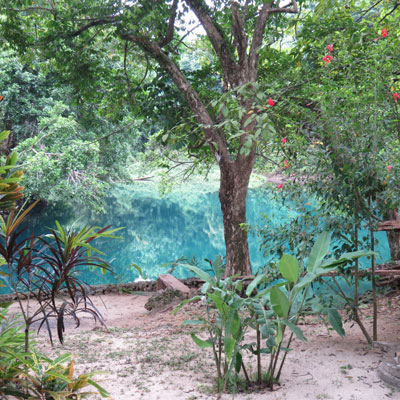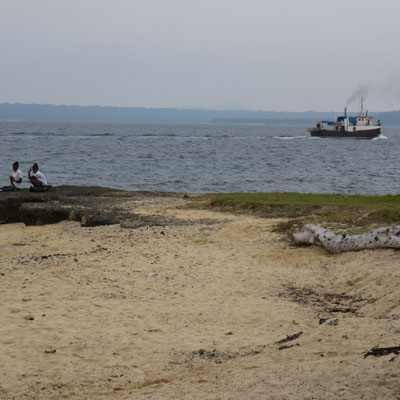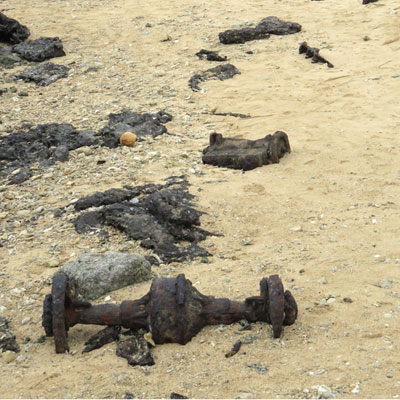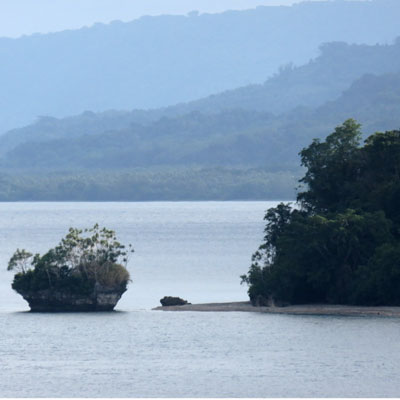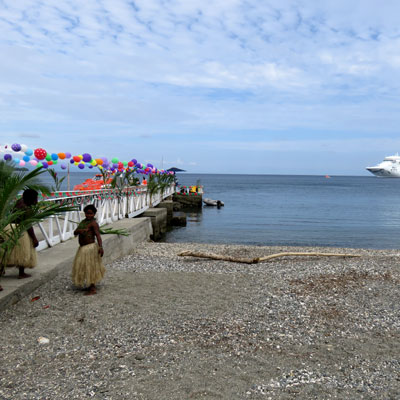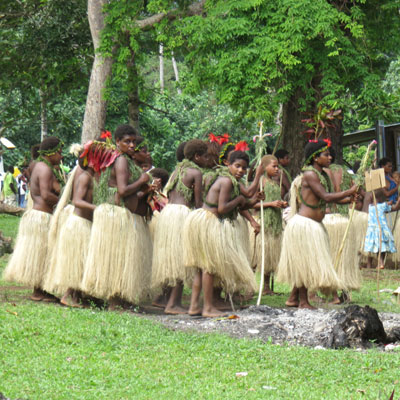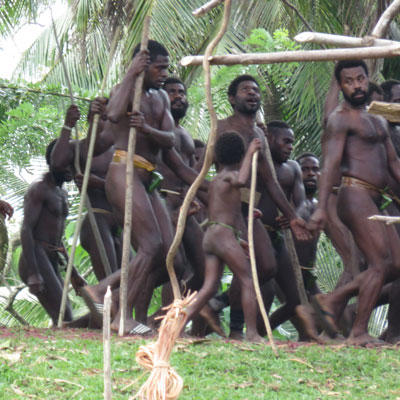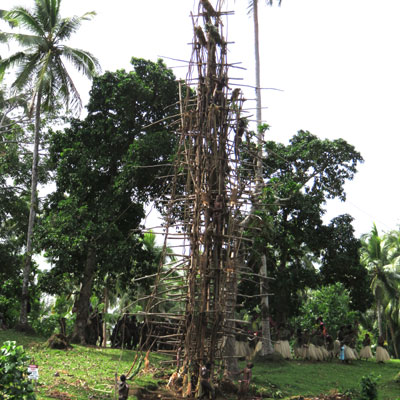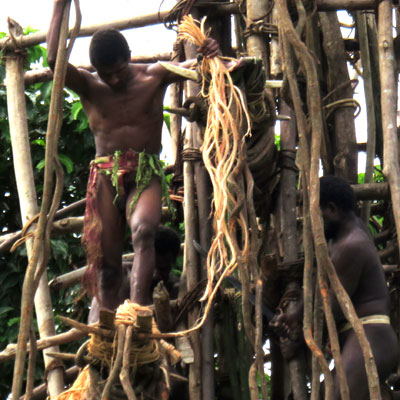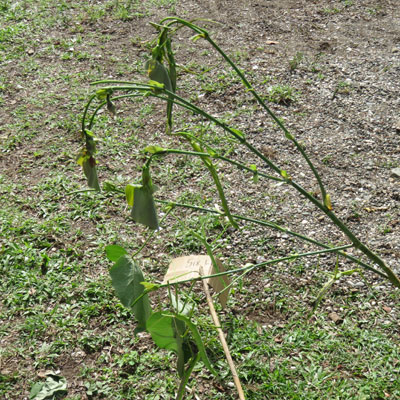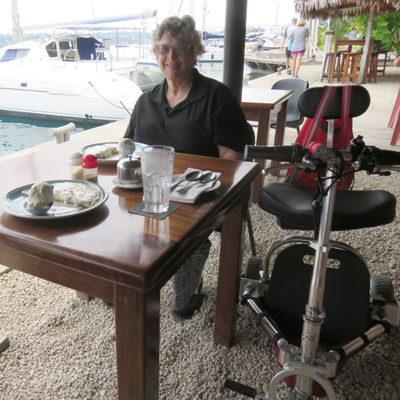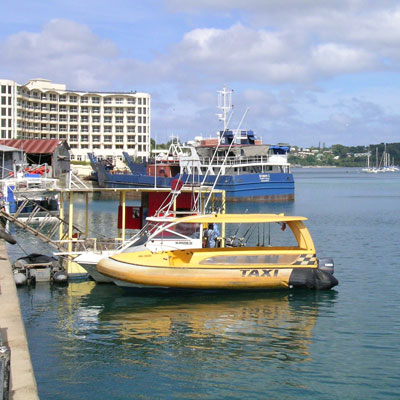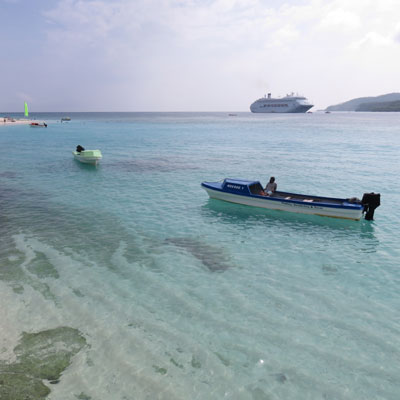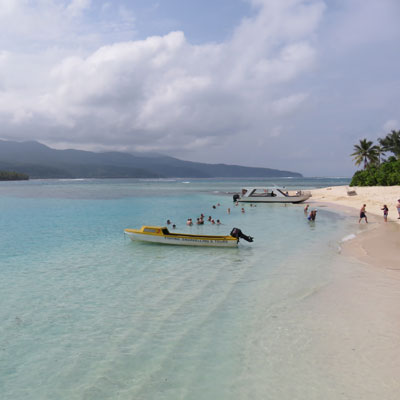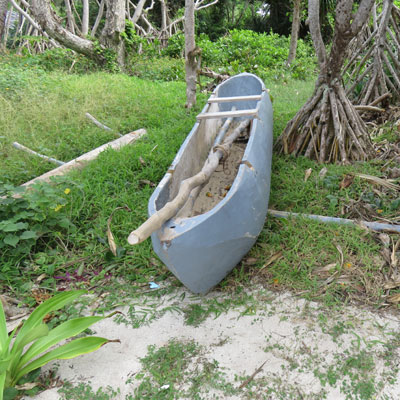Islands of Vanuatu cruise on Pacific Jewel in June 2018
Vanuatu Islands - 2018 (download 633KB PDF file) | Map
Vanuatu islands - 2018
Introduction
Our latest adventure took us to Vanuatu, aboard P&O Australia’s ship Pacific Jewel, out of Auckland. After three days sailing on calm seas we arrived at our first port of call.
Luganville - Capital of the island of Espirito Santo
This island, generally referred to as Santo by locals and expats alike, is best known as a wartime base for mostly U.S. forces, who swelled the population from around 8,000 to half a million for the duration. As you might imagine, their presence had a huge impact on the island, both positive and negative, much of which is still evident today.
The most positive, and obvious, sign is the infrastructure they left behind. Most notable is the excellent road which runs down the east coast of the island from Port Olry in the north to Luganville in the south (it may extend to the west of Luganville for a short distance but we didn’t travel that way.). This road continues to be well maintained but this is at the expense of virtually all other roads, which are barely paved and are mostly rough tracks, scoured by the tropical rains into chasms and potholes, with huge, exposed roots of nearby trees forming an extra hazard. We had booked a private tour and travelled in a four-year-old minivan that appeared to be at least ten years older; it is not just the bodies of the passengers and drivers which suffer from the bumpy ride! Many of our fellow passengers had taken either the ship’s tours or picked transport up at the quayside. They were transported in the backs of pick-up trucks and considered themselves fortunate not to have been thrown out many times throughout the day; walking would have been both quicker and safer, they told us!
As always, we were pleased we organised a private tour as we learnt so much more than if we'd tried to go-it-alone or gone on a ships tour, which seemed to comprise about 20 mini-buses and pick-up trucks following each other around. Our driver was obviously aware of that and took us to all the sights in reverse order, so in the main we had them to ourselves, or at least, a lot less crowded than they might have been. We also went to some local places like the fruit and vegetable market that the tours didn't visit, which would have been disappointing as they are often the most interesting way to learn about the local customs.
We went first to the Ladies Market, where we saw splendid examples of all the fruit and vegetables grown locally. It is called the Ladies Market as they not only grow the food but also sell it. We were curious to see that all the stall holders were wearing purple clothing and were told that they were all from the same village and it was that village’s day to sell their produce. Another day another village will be there, with the women wearing red or blue or green and so on – the colour identifying them as belonging, and presumably stopping anyone from another village taking custom from them on their day. With all the focus these days of the evils of plastic carrier bags, it was both interesting and humbling to see that the produce was transported to market in baskets woven from palm fronds, held together by threading the stripped spine of the leaf through the opening, thus also making a handy handle. Smaller versions were provided for customers to carry home their purchases.
Next we visited the picturesque Champagne Beach, with its pale golden, palm-fringed beach, like something out of a travel brochure … oh, wait! It was, indeed, straight out of a travel brochure! This is an excellent, safe swimming and snorkelling beach, ideal for families and those wanting to explore the multi-coloured fish which swim close to the shore. The view was enlivened by clothes lines set up by stall holders, on which a colourful variety of sarongs, dresses and shirts were pegged on display for sale.
We had driven to the beach via some coconut plantations and a lot of breadfruit trees, as well as lots of jungle and a variety of houses ... everything from an American multimillionaire's vast spread (for use three months a year - sometimes!) to the most mean and meagre cluster of leaf huts, every bit as poor as those we saw in the Solomon Islands last year. Here, the women eke out a living from a small garden to grow food for the family while the men laze around drinking kava and coconut liquor. Such contrasts in wealth and lifestyle!
We drove for miles through plantations which were part of a farm owned by the Japanese. As well as growing coconuts, they breed beef cattle (Santo beef is world-renowned as among the best quality) which they send back to Japan. This surprised us as the Japanese are renowned for their own Wagyu and Kobe beef and we did not suppose they would have had a market for another prime breed.
There were also huge tracts of noni plants. Noni or Indian Mulberry, is actually a species of the coffee family. Native to Southeast Asia and Australasia, the Noni is used in many traditional medicines ... so many, apparently, that one wonders what it cannot cure. The medicinal fruit is much favoured in China and this was a Chinese-owned farm which sent all the produce back home.
It is encouraging that these Japanese and Chinese enterprises are providing work for local labourers, though at extremely meagre wages and with no job security. We were shown some very dilapidated and rusty corrugated iron shacks, left over from some wartime facility, which we were told were used as accommodation for the labourers. The general view seemed to be that they were fortunate to be provided with shelter, but it drove home to us that ‘fortunate’ has very different meanings in different cultures.
We had lunch at Turtle Bay Lodge, a resort in a sheltered bay where we watched the fishermen spread and then bring in their nets...empty, so they moved a few metres away and tried again and so it went on for the whole hour we were there. The food was lovely, green papaya salad and prawns with 'garlic bread' – actually a very thin pizza base with chopped garlic sprinkled on it then baked - nutty and delicious, much nicer than the traditional, greasy sort made with too much butter! My coconut water, straight from the nut, and Martin's Tusker beer were just the thing for a warm day. It was about 26 or 27C, with very low humidity, so very comfortable.
After lunch we went to Matevulu Blue Hole (one of the many Blue Holes, which appear all along the coast), where the water is astonishingly clear and even more astonishingly blue - indescribable but the photos do it justice. I think it must be the minerals which give it the colour as the sky was grey and there was no other explanation for it. The pools (holes) are features of rivers which run down to the sea, with the water gradually becoming paler and paler blue as it nears the ocean, until it is completely colourless for the last part of its journey. We did not go to the hole the ship’s tours visited and we had it to ourselves. The only sound was the birds calling in the thick forest which surrounded the water hole. We could have stayed there all day! Apparently the one the others visited was very crowded, dirty and had dangerously broken, slippery steps into the water, so we were very pleased with our guide’s choice for us.
Our final call was at Million Dollar Point, which was something of a disappointment. This place is the location of a massive dump of all the military materiel which the USA did not want to return to the States after the war, but which it would or could not sell to the country… millions of dollars’ worth, hence the name. It was all simply bull-dozed into the sea and left to rot; tanks, vehicles of every sort and goodness knows what else. According to the literature we had read, the rusting remains are still clearly visible at low tide.
Although it was low tide when we went and a lot of the rusting military equipment was exposed, there was no way of telling what it was (except for one axle) and no signage explaining anything. We had both been under the impression that there was a viewpoint where you looked down through the crystal-clear water and could get a better idea but this wasn't the case and we found ourselves on a beach looking at a rather unremarkable stretch of sand and water. Of course, had we been able to dive it may have been a different story, though no-one from the ship seemed to have found it so.
Nearby, there is the wreck of the USS President Coolidge, which is an important dive site and which is very well set up for those who wished to explore the wreck, but as for the rest, there was little to see.
A story about the aftermath of the war, was told by our guide. Apparently the Vanuatu government had demanded reparation from the Japanese for the depredations to the country during their assault but Japan’s coffers were empty and they could not pay. A compromise was reached and it was decided that the Toyota factories would produce cars only in Japan and that all their profits would be sent to Vanuatu in payment of the debt. This is what happened and only when the debt had been fully repaid did they start manufacturing their vehicles in other countries. We have no evidence as to the veracity of this story, but it sounds plausible and we thought it an interesting possibility.
While we were there, however, we did see evidence of a true story, playing out today - a small ferry boat bringing students from Ambae, the island which is now covered in ash from the continuously erupting volcano. It had been on our TV news, at home in New Zealand, a couple of weeks before that the Vanuatu government were contemplating evacuating and re-settling the whole island, and the students we saw were among the first - the schools could no longer operate and so they were being brought to Santo for their education, though no-one seems to know where they will lodge. Apparently the rest of the island’s population will have been brought over during June and be finished by July - so sad for them.
Our guide showed us some photos on his phone, sent by a relation who lives on Ambae, which perfectly illustrated why life on the island is no longer viable. A view of his village showing the lush green grass, coconut and banana trees, as well as vegetable and taro farms of two years ago are now completely barren and covered in ash - not a leaf or blade of grass in sight, just a uniform grey everywhere. Even the fish are unable to sustain life in the ash-choked waters along the shore and so their other staple source of nourishment is no longer available.
We returned to the ship in time to walk through the colourful handicraft and souvenir market which had been set up on the quayside. The same groups of singers and dancers, as well as an ‘honour guard’ of warriors making an archway with their staves, who had greeted our arrival, welcomed us back to the ship and then bade us farewell in traditional manner – bamboo whistle and drum music played with more enthusiasm than melody but accompanied by such wide smiles that one could not help but enjoy it.
After dinner, as we sailed towards our next destination, we were fortunate enough to see another volcanic island, Ambrym, in the distance. We were able to see the red glow of the volcano, which is in a constant state of agitation, with the roiling red lava lake in the crater liable to blow at any time. It was a cloudy night but this helped our view, as the fiery red was reflected off the base of the clouds making it easy to see from afar. We thought it a great shame that no announcement was made from the Bridge to tell our fellow passengers that there was such a special sight to see, so most people missed it.
Pentecost Island
Pangi, on Homo Bay is the largest village on this long, narrow island, and it was here that we anchored and then took the ship’s tenders ashore. We were there to witness Melanesia’s most remarkable custom, naghol, or land diving. The ceremony is a fertility rite to ensure a good yam harvest to sustain the people through the coming year and is only performed in April, May and June when the vines are of the correct strength and degree of elasticity to ensure safety.
The men of the island build, on the side of a hill, very high ‘scaffolds’ of bamboo and other long, straight pieces of wood, with platforms at several stages. Long, strong vines are attached to the framework and a pit of softened earth is dug into the downward slope in front and at the base of the tower.
After much singing and dancing, and the intake of quantities of kava, men and older boys, then climb to the various platforms (the higher, the more daring) where they tie a vine to their ankle and swallow dive off, just grazing the tops of their heads on the soft earth – if they have judged the length of the vine correctly. If they haven’t, the soft soil breaks their fall and lessens the risk of serious injury, although does not remove it altogether and a poor young man appeared to dislocate his shoulder while we watched. He was immediately tended to by the ‘medical team’ on hand and later seemed no worse for his experience. The dancing and chanting carries on throughout the ceremony, getting more frenzied as each man or boy gets ready to dive, and there cannot have been anyone present who was not aware of the great significance of what we were watching. It was a privilege to be able to see this ancient rite being performed and although we know that P&O had paid for us to see it on this occasion, it was still a genuine event and not merely a show staged for the tourists.
Most people showed the correct amount of respect and behaved with dignity throughout, but we were disgusted at the antics of the ship’s photographers who cavorted around with a mock life ring emblazoned with the ship’s name and ‘Pentecost’ trying to get people to pose for a photograph in front of the tower. Fortunately not many were crass enough to do so, though we were surprised anyone would – and also that one of the village elders hadn’t dismissed them from the arena.
As an aside - we were astonished at the number of people who had no idea what they were going to see on the cruise and who knew nothing about the history of Luganville, for example, nor, even more shockingly, about the land diving on Pentecost which was surely the main reason for taking the cruise! That said, it was incredibly cheap as for some reason P&O had difficulty filling the ship and discounted the fares very heavily. We can only assume that it was the prospect of a 10-night cruise for NZ$80 a day or less, including all food, entertainment and ‘hotel services’ which attracted people looking for a break, who didn’t much care where it went. The fact it sailed from and back to Auckland was also a big draw, as no expensive international flights were needed, which can often put such cruises out of reach.
We were lucky enough to be able to buy a pair of these discounted tickets and even got an accessible cabin for the price. It was about double the size of our usual accommodation and the bathroom was also almost three times the size of the normal cubicle. This made for a very comfortable stay as all my mobility paraphernalia was stowed out of the way but readily available when I wanted it.
We did have a bit of excitement while we were on the island - a helicopter landed just the other side of the trees from the arena. It was picking up one of our passengers, who was being evacuated to Port Vila hospital following a heart attack. Another passenger, rather a know-it-all, announced that this was the first time a helicopter had landed on Pentecost ... if that had even possibly been true, one could not have helped but be in awe of the equanimity of the local people, especially the little children, who merely glanced up at it and then went back to their playing, singing, dancing and in the case of one little tot, showing off his twig covered in huge stick insects. He was such a cutie that I think he will have amassed the biggest pot of dollars and Vatu at the end of the day! There were many collection boxes around, in aid of the school, medical centre and various other aspects of village life and we were happy to help, even in such a small way.
Port Vila – Capital of Vanuatu on the island of Efate
As we had been to Port Vila on many previous holidays, we had no particular plans for the day, except to revisit a particular supermarket and a favourite bar/restaurant, The Waterfront, also, coincidentally the name of our favourite local bar/restaurant in Mangonui and the main restaurant on the ship!
Martin was ready for a long walk and I had my little electric mobility scooter so we set off for the 40 minute walk into town. We enjoyed looking at all the port activity, fishing boats and general town-scape as we made our way round the bay. It was a somewhat nerve-wracking ride as the pavements are unsuitable so I rode on the road, facing oncoming traffic. All the drivers were very careful and many waved and smiled, presumably at seeing such a strange vehicle. It was not the smoothest ride but we made it and the green battery light only went off just as we got to the bar, which meant that I would (probably!) have had enough juice to get back to the ship but as we'd already planned to taxi back, it wasn't a problem.
As it was a Sunday almost everything was closed, except our chosen destinations, including one of the big duty free stores and most restaurants. There were some very grumpy folk on board as they couldn’t understand why the local businesses hadn’t opened up especially because a cruise ship was in. They didn’t seem to understand that for some people, money isn’t everything and that, in general, the people of Vanuatu are very religious and wouldn’t dream of breaking the Sabbath. In fact, many people spend the day in church, the women mainly in white, with straw hats or flower coronets and everyone dressed in their ‘Sunday Best’ clothes.
We stopped at the Bon Marche supermarket, a very ‘local’ shop selling everything from caviar and Roquefort cheese to hose pipes and frilly dresses. We bought a packet of Tanna coffee, for which Vanuatu is justly famous, and a large bottle of the unscented talcum powder we like, which only seems to be available on tropical islands! Having fulfilled our shopping list, we carried on to The Waterfront.
On arrival we were greeted by the same waitress whom we had encountered on every past visit; she is possibly the only person in the whole country who never smiles! She also moves at a glacial pace but that’s fine as we were in no hurry and we knew we would get our drinks and food eventually. Sad to say, prices had doubled since we were last there and the lobster and prawn lunch we had promised ourselves was way out of our reach, which was very disappointing. Never mind, we consoled ourselves with ‘dessert first’ and had a sinful banana and cream pancake each to sustain us until we returned to the ship and had a nice lunch from the buffet. That evening we sailed for our final port:
Mystery Island
This tiny, uninhabited isle is situated just off-shore of the slightly larger Aneityum. The people of Aneityum believe that Mystery Island is haunted and no one is willing to live there. All the people serving the tourism industry on the island live in Anelcauhat, the main village of Aneityum, and commute daily in small boats.
Mystery Island itself is a snorkelers’ paradise, with the waters surrounding it being a designated marine reserve. For those not wishing to swim, it is possible to walk right round the island in about 45 minutes, or explore the garden paths which meander over the island, before stopping off at a stall offering reviving cups of the Tanna coffee to which we referred earlier. There are also some stalls selling the ubiquitous sarongs, shirts and dresses in bright ‘island’ prints, but little else for the day-trippers such as cruise ship passengers who overrun the island for the few hours they are there. There are some basic bungalows which may be rented for stay-put holidays but these are not situated where the crowds might gather.
The most striking feature, however, is the long, grass airstrip (built by the Americans during WWII), which is apparently still in use, though in two visits we have yet to see a plane … someone once turned up to the rudimentary ‘terminal’ with a suitcase but whether they are still waiting or not is a, well, a mystery.
Back to Auckland
From Mystery Island we began the two-day sail back to Auckland at the end of an extremely interesting and educational but also relaxing cruise… well, relaxing for us:
During the first night after Mystery Island, the Captain announced a medical emergency which required urgent hospital treatment. We would be going full steam ahead for Auckland and would arrive on the Wednesday night rather than Thursday morning. We were, unfortunately, out of range for a helicopter to make a pick up at sea and take the passenger to a nearby hospital and it was decided that, in any case, he needed the facilities of a large, modern specialist hospital and that meant Auckland. A seldom-considered aspect of island hopping in the Pacific Ocean is the vast distance between points of civilisation, and even more so between modern, well equipped and specialist-staffed hospitals.
Our normal cruising speed would be around 14 knots but we did in excess of 17 knots, through noticeable swells, until the ship started to shudder and it was determined that the propeller was becoming unbalanced through having insufficient water to move so we slowed slightly until the seas smoothed out again. We were then recorded on radar (by our son-in-law and grandson!) doing 20 knots past Whangarei Heads (just south of where we live in the Far North of New Zealand). We berthed in Auckland by 11pm, which was 7 hours earlier than originally scheduled and the patient was off-loaded to the waiting ambulance. We do not know how he fared but hope that we were in time to save him.
The Pacific Jewel is by no means the star of the fleet and there are some inconveniences and illogicalities in its layout. Overall, however, we found the condition of ship to be perfectly acceptable and the on-board services very efficient and friendly.
Our one gripe, if we had to have one, was that hot food at lunchtime in the main dining room was invariably served cold or, at best, lukewarm. In the evenings, however, the same staff (and kitchen) produced hot food on every occasion. The standard of food in the main dining room at lunchtime was also very hit and miss but the dinners were each better than the last and the quality and imaginative preparation was as good as many land-based restaurants and certainly most cruise ships – though the choice was more limited than on some. The Pantry, the informal buffet-style restaurant, offered a huge variety of dishes from around the world but there was a shortage of seating so sometimes the food got cold while seeking a table. That was soon remedied, however, by opting for the salads and cold dishes on offer. We never tried to eat there in the evening but understand that the choices were good and people we spoke to all reported that they had enjoyed their dinners.
The early arrival in Auckland made no difference to anyone except those who were denied a final night gambling in the casino, as international rules dictate that all such activity must cease when in port. We disembarked at the appointed hour next morning and had an easy drive home to our family and a delicious roast leg of lamb for dinner, served piping hot!
Vanuatu Islands - 2018 (download 633KB PDF file) | Map

